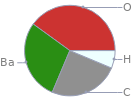Input interpretation

barium 2, 4-pentanedioate octahydrate | elemental composition
Result

Find the elemental composition for barium 2, 4-pentanedioate octahydrate in terms of the atom and mass percents: atom percent = N_i/N_atoms × 100% mass percent = (N_im_i)/m × 100% Plan: • Write the chemical formula and gather atomic masses from the periodic table. • Determine values for N_i, m_i, N_atoms and m using these items. • Finally, compute the percents and check the results. Write the chemical formula: Ba(CH_3COCHCOCH_3)_2·8H_2O Use the chemical formula to count the number of atoms, N_i, for each element and find the total number of atoms, N_atoms, per molecule: | number of atoms Ba (barium) | 1 C (carbon) | 10 H (hydrogen) | 30 O (oxygen) | 12 N_atoms = 1 + 10 + 30 + 12 = 53 Divide each N_i by N_atoms to calculate atom fractions. Then use the property that atom fractions must sum to one to check the work: | number of atoms | atom fraction Ba (barium) | 1 | 1/53 C (carbon) | 10 | 10/53 H (hydrogen) | 30 | 30/53 O (oxygen) | 12 | 12/53 Check: 1/53 + 10/53 + 30/53 + 12/53 = 1 Compute atom percents using the atom fractions: | number of atoms | atom percent Ba (barium) | 1 | 1/53 × 100% = 1.89% C (carbon) | 10 | 10/53 × 100% = 18.9% H (hydrogen) | 30 | 30/53 × 100% = 56.6% O (oxygen) | 12 | 12/53 × 100% = 22.6% Look up the atomic mass, m_i, in unified atomic mass units, u, for each element in the periodic table: | number of atoms | atom percent | atomic mass/u Ba (barium) | 1 | 1.89% | 137.327 C (carbon) | 10 | 18.9% | 12.011 H (hydrogen) | 30 | 56.6% | 1.008 O (oxygen) | 12 | 22.6% | 15.999 Multiply N_i by m_i to compute the mass for each element. Then sum those values to compute the molecular mass, m: | number of atoms | atom percent | atomic mass/u | mass/u Ba (barium) | 1 | 1.89% | 137.327 | 1 × 137.327 = 137.327 C (carbon) | 10 | 18.9% | 12.011 | 10 × 12.011 = 120.110 H (hydrogen) | 30 | 56.6% | 1.008 | 30 × 1.008 = 30.240 O (oxygen) | 12 | 22.6% | 15.999 | 12 × 15.999 = 191.988 m = 137.327 u + 120.110 u + 30.240 u + 191.988 u = 479.665 u Divide the mass for each element by m to calculate mass fractions. Then use the property that mass fractions must sum to one to check the work: | number of atoms | atom percent | mass fraction Ba (barium) | 1 | 1.89% | 137.327/479.665 C (carbon) | 10 | 18.9% | 120.110/479.665 H (hydrogen) | 30 | 56.6% | 30.240/479.665 O (oxygen) | 12 | 22.6% | 191.988/479.665 Check: 137.327/479.665 + 120.110/479.665 + 30.240/479.665 + 191.988/479.665 = 1 Compute mass percents using the mass fractions: Answer: | | | number of atoms | atom percent | mass percent Ba (barium) | 1 | 1.89% | 137.327/479.665 × 100% = 28.63% C (carbon) | 10 | 18.9% | 120.110/479.665 × 100% = 25.04% H (hydrogen) | 30 | 56.6% | 30.240/479.665 × 100% = 6.304% O (oxygen) | 12 | 22.6% | 191.988/479.665 × 100% = 40.03%
Mass fraction pie chart

Mass fraction pie chart